But first, for those who do not fall into the hands of No. 11 of the magazine for 1998 briefly recall the content of the previous series." So, speaker system 75 ░ C thought "in the mind" and, in principle, should be heard very well. However, all the charm mass Assembly, structural simplification, the optimality Board mounting electrical filters, internal creepy wiring plus the presence, as it turned out, no one needs protection completely "kill" the sound. Therefore it is proper to consider 75 ░ C-001 (150 ░ C-001) as a good set of parts designer DIY. It includes a pretty decent speakers with high sensitivity, elements electric filter (coils, capacitors, wire resistors) and veneered with natural veneer workpiece housing with slotted under the speaker holes.
These sets are very popular abroad (we are also sold in some stores and on the "crust"), as allow rukastogo audiophiles to realize their ideas and at the same time save a considerable amount. Therefore, the first phase upgrade, and more specifically tuning 75 ░ C-001 was conducted complete disassembly, including removal of all internal wiring, including connections to the on-Board filter, and extra components of the protection device and the quenching resistors). Then the basis of the remaining elements have been optimized scheme remade the the crossover filters. The entire internal the installation was carried out high-quality speaker cable oxygen-free copper.
For damping of standing and reflected sound waves inside the rear and side walls were pasted sheets fibrous insulation material used as a filter in kitchen hoods. In conclusion, it was proposed steel "shovels" terminals replace high quality gold plated "posts". That's all that was done on the first stage of works. So simple and, in General, obvious improvements the basic design of the most positive impact on the sound quality. The new version of the speakers got the name 75 ░ C-SE, and while they fully satisfy our requirements. However, after a series of tests, it became clear although Special Edition sound not the best example of their pristine version, but to the level of a decent Hi-Fi is still not hold out. It became apparent that the full potential inherent in these domestic systems that are far from exhausted. Gradually matured, and the desire to once again take up the soldering iron and finally bring them to mind. Especially since by that time the author managed to upgrade other components tract. In particular, were removed transistor switches, shunt output in the turntables vinyl and CDs, and instead of them used reed switches, in addition, the turntable was replaced with all internal wiring, including connecting interconnect a cable.
The subtleties of articulation
As before, before you start tuning-II plan was developed it is held. As a first step it was decided to try a two-wire connection to the power amplifier and method bi-wiring, because the testing of foreign convincingly AC demonstrated its effectiveness. It was then assumed to increase the damping of the WOOFER and midrange speakers through increasing the number of absorbers within the housing and in Boxing the midrange. Finally, I wanted to get the best the articulation of the bass, though it became more collected after the first phase of the upgrade, but still sounded not enough convincingly. Actually, with the bass all started, as it is the sound in the low frequency range causes the most complaints the owners of 75 ░ C. The reason for the "mumbling" in this case is quite obvious: a huge cone DN-3 is too heavy for so you effectively shadenfreude even midget the output impedance of the power amplifier. Under these conditions, the output only one to influence him by acoustic methods, i.e. place them inside a additional sound absorber. The deterioration of the sound 75 ░ C at lower levels may also occur due care resonance bass-head with the frequency settings bass reflex.
After 8-10 years of operation inevitably corrugations dries up, and its flexibility is reduced, which leads to to increase the resonant frequency of the loudspeaker. Even worse, in this change also and indicators acoustic quality factor DN-3. And what do we do now? Irina A. Aldoshina, once headed the development of 75 ░ C-001, recommends experimentally to measure parameters of an "aged" basovich (the resonance frequency of the outdoors Fs and full the quality factor Qts) and by known methods to calculate the new the tuning frequency of the port. Then configure it to higher frequencies, reducing the length of the pipe. Have to cut hacksaw some part of it, but take your time, remember "seven twice...". Double-check the correctness of the made by you of calculation. And it is better to start the "circumcision" experimentally make sure that the bass after that it will improve. For this, we recommend to make out of cardboard or other material two tube length 60 mm (slightly more than half the length of the phase inverter 104 mm), one of which should fit to enter another.
The outer external diameter 80 mm corresponds to the diameter of the port. After that, the column housing removed the staffing phase inverter. This will be easy, because he is not fixed and is held in the hole on the front panel due to the tight fit. Then in his place is tightly fitted cardboard "telescope", and change its length to achieve the most acceptable bass.
Optimum it is best not caught on their hearing, and on a curve the input impedance of the speakers. However, experiments in the real area of 20 square meters showed that the nature sound 75 ░ C at low frequencies when configuring port improved not so much, as this was to be expected. Where more simple and effective was just damping port plugs-liners. This sheet of foam - best dark-colored, so they are not contrasted with front panel - cut washers with a diameter slightly greater than 80 mm for reliable fixing in the pipe.
The optimum thickness of the liner depends on the density of the material. It is best to take not very a thick sheet, to be able to change the depth damping installing several such tubes. On column a tone signal with a high level of low-frequency components, and the change in the number of sacks achieve top quality bass.
It is easiest to appreciate it on a big the drum ("barrel") or the double bass, the sound of which this should become much clearer. But don't get too carried away, as if tightly to score a bass port, the last generally stop to work and acoustic design will turn into a "closed box". Which is not good because HTN-3 for this is calculated. According to the author, the best results are obtained if after installation inserts the intensity of the air flow drops by about by half. The total thickness of the medium density foam with approximately 20-30 mm. So it is possible to achieve the most a good compromise: the bass becomes more accurate and elastic, not too lost in the depth and the intensity. To notice the effect will be much easier if high frequency "crush" treble booster. And even better to listen to the bass section separately by connecting column a two-wire circuit.
Game four wires.
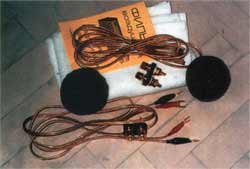
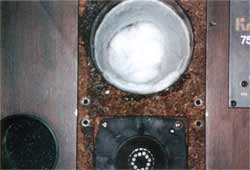
Now will live here the midrange.
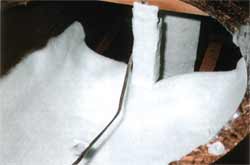
Pasting smokeparticles pipe Midrange speaker and stand.
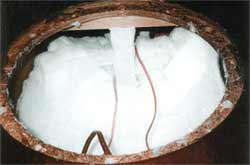
Same as above, plus gauze Mat No. 2 (see text).
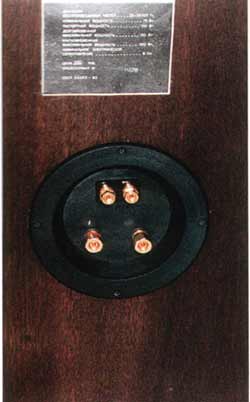
Sockets for bi-wiring outside...

...and inside.
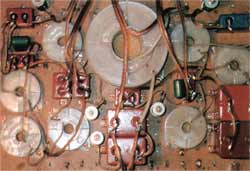
"Presence is minimized" crossover. To simplify the impossible - unneeded already unsolder.
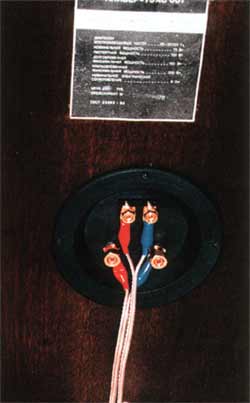
The contact? There contact!
Thus, we have gradually come to the next stage upgrade - organization scheme of bi-wiring. For him have to acquire three-meter speaker cable oxygen-free copper OFC. Given the high power speakers recommended the cross section of conductors - not less than 2.5 to 4 sq mm is Considered that for wiring of the bass section is preferable to pure copper, and MF/HF is better suited silver plated copper. Now the market offers a huge number of cables, and here just opened a boundless field for experimentation. In the author's version, which gave good results, for connect basovich used OFC cable company Jamo section 4 mm (80-100 $ /m), and at the top and mid - Vampire Wire OFC Speaker Cable with a cross-section of conductors of 2.5 sq mm (40-50 $ /m).
They were also used for internal and posting in columns. Then you should think about purchasing qualitative input terminals. In principle, of course, can to do without them, solder the cables directly to the input of the crossover filters. This saves a decent amount of money and avoided a number of contact passageways. But you almost deprived of further need, i.e. selection speaker cables (not disassemble same column for each time his replacement). Moreover, sealing tightly uncomfortable, because complicated by the connection of speakers because of the risk to get lost in coils of cable. Therefore, if you decide to make tuning at 75 ░ C the maximum, do not skimp and get a good gold plated "screws". Unfortunately, they are quite expensive: not cheaper 300-400 rubles per couple (includes the products of famous companies, and not Chinese consumer goods). Since for each column in two-wire connection is required for 2 couples, their bi-wiring will cost quite a tidy sum.
Plus you need to splurge on connectors - "spatula" or "bananas" - 4 pieces on each cable. You will need 16 of these jacks and the price each at best about 30-40 This is the RUB. the accounting Department. However, if you already managed to modify the column to level 75 ░ C-SE, your costs will decrease by half, as half of the cables and connectors you should already be. Acquired connectors should press on the stripped ends cable length. This is best done with the help of a crimping tool, but at a certain accuracy good results can be achieved using a conventional pliers. After the cables are ready, you can proceed to the "autopsy" speakers. Will assume that the starting point of the tuning column II are level 75 ░ C-SE. On the cover with connectors installed optional screw pair for MF/HF speaker. Then extracted from the housing cost of the crossover. Inputs midrange and High-pass filters are disconnected from the circuit WOOFER and a separate cables attached to its helical pair. (Please for reliable soldering copper conductors cable large diameter requires a soldering iron with a capacity of not less than 80-100 watts, so stock up on them in advance. Keep in mind, that cold soldering can negate all your efforts to improve sound quality.) Then produce the corresponding change the installation in the filter, i.e. shared earth the circuit of each speaker.
Actually, this "electric" phase tuning-II completed. All further operations are associated with silencing the internal volume of the housing to combat reflections of a sound waves inside it. For this you will have a little more splurge and buy a few sheets of fibrous absorbers (filter for cooker hoods), one package which stands today at about 100 rubles. this Material is necessary to absorb the energy of standing sound waves from the back the sides of the diffuser. A sheet of porous polymer rolled into the tube and glued to the inner walls of the cylindrical Boxing, insulating midrange speaker from the rest of the volume.
Thus in order to leave enough space under the basket DS-1, from the upper edge of the box need to retreat approximately 50 mm To increase the degree of damping of the midrange on the bottom of the pipe from the absorber a good idea to place a small Mat of loose wool (also suitable and cotton balls). After this is the same sound absorber within the housing of the column (via the hole for the woofer) to paste over the outside surface of the phase inverter tube and the insulating Boxing mid-woofers and also a wooden rack-spacer between rear and front walls. Then of gauze need to sew more one Mat, which is loosely stuffed with about 0.8-1 kg wool. Mat No. 2 is placed between the wooden spacer and Boxing the midrange in the upper part of the housing.
But it is to fix (glue, buttons or Shoe studs) on the sides and on the spacer so that the Mat overlaps about half of the lumen of the height of the body. Clearance required for the sound wave from the back side HTN-3 could easily sneak into the top half of the housing. At the same time, the presence of insulation material provides effective dissipation of the energy of the sound waves reflected from the upper wall of the housing. Particular attention should be paid to the fact, to Mat No. 2 not blocked bass port. For to avoid unwanted overtones under the influence sound waves from the WOOFER, try to put the wires from the midrange and tweeter under the layer of insulation material. In the extreme case, they can just fix it on the side the walls.
Feel the difference
Well, that's all. Now you can assemble the column (which we an analogy with the indexing depth tuning, entered Ken Ishiwata on the Marantz company, assign the conditional index 75AC-SE mkII) and begin their tests. If your the amplifier has two pairs of output terminals for acoustic systems, it makes sense to connect the cables to different pairs. The more than that many models of amplifiers provide the opportunity switching the connected loudspeakers that gives separately to listen to the sound speakers and WOOFER, and The MF/HF bands.
Before proceeding to listening, make sure that the polarity of each speaker in columns followed. With proper phasing of the speakers the source of the sound when playing nonprogramme or write pink noise should be exactly between the speakers. Well also "sound" column moving signal tone in the frequency range 20-20000hz (tracks 16-18 on the CD "in Our the city!" the Annex to the "Salon AV" No. 3/98). The volume the speakers should be more or less uniform in all this the range, except for the lowest frequencies. If something seems suspicious to you, double-check the correctness of installation of filters and phasing of the connections of the speakers. If you don't have that or of the other test CD, then just look familiar to you entry to detect any anomalies in the sound.
After the "qualification tests" triggered test: was already taken most diverse the sound material - from heavy metal to classical music and instrumental jazz. And what do we hear? On the first (always the most correct) impression of naturalness and sound resolution 75 ░ C-SE mkII at medium frequencies increased hardly not on the order. On vocals, for example, were not heard clearly only the subtle nuances of the manner of performance, but breathing singers, the rustle of clothing and other quiet sounds that used in most cases the "old" 75 ░ C (even the SE version) just ignored.
High, figuratively speaking, steel is thinner human hair" and louder than the bell. If before the sound of brushes on cymbals is just pleased, now he admires: audible even as individual wires slide on the surface of the plates. And what about the sound of a triangle Symphony orchestra! Bass also and almost got got rid of the "mumbling". Although it is true, however, what to get from 75 ░ C as a clear sound at lower levels, like imported Hi-Fi stereo high class not managed. However, perhaps a fair share of the blame for that lies on very room, as good room acoustics listening to the audio salons is achieved only after special handling their walls and floor.
Important and sizes the listening room: small (especially square shape) it is very difficult to achieve a clear bass because inevitably arise in them standing sound waves. Therefore, even from the very good and expensive speakers seldom get to hear the truly correct bass in a real dwelling. By the way to say the room where it lives for your stereo system, preventive purposes, it is useful from time to time "sound" sliding audible tone. In this beautifully revealed resonances glass bookcases, the clatter of dishes and the other such stray sounds. Because under normal circumstances they masked by the music, but subconsciously perceived by the brain as "mud." Upon detection of such flaws need the room be sure to "cure". For example, the jingle of glass in the Cabinet and in Windows fluff on the perimeter sealants mastic or under shelves with dishes to put rubber rings etc In the presence of distinct resonances in the frequency range of 100-500 Hz try changing the location of the speakers in the room and again it "prohodite". The uneven sound at high frequencies and their excessive brightness can be reduced by hanging the speakers on wall carpet and putting on the floor of the Palace. If, on the contrary, bathroom needless peregusna and treble are sorely lacking, use the knob treble in the amp and compensiruja these losses.
Well, now is the time to enjoy the sound of the speakers 75 ░ C SE mkII, you may be immediately and do not know - so he transformed. Given the clear better sound quality economic efficiency tuning of columns does not cause the doubt. Because otherwise to achieve adequate the level of sound quality would have to buy new imported the acoustic system at a cost not less than $450-600.
PS.. After "sorted out" with the speakers, you certainly have a desire to further improve the sound stereos. Then it's time to use the proposed the author of the search technique search "bottlenecks" ("Catching fleas scientifically, Salon AV" No. 3/99) and identify which of components is now the most "weak link". When increased class speakers, this can be the source of the signal or amplifier. There is a reasonable question: why not to Refine them? The more that our magazine has already published article on "cold", "warm" and "hot" upgrade your Hi-Fi components (for example, "the Best is the enemy good", "Salon AV" No. 2/99). It is possible that in near future edition will come back to this topic. Well, yet - we wish you success in the noble cause of upgrade and tuning your Hi-Fi equipment. Because nothing pleases the heart a true audiophile, the sound brought them to mind own stereos.
P. P. S. Before complete dismantling of AC we suggest that you still time to soberly assess their skills and decide whether you such feats of labor.
Author: Konstantin sky, Salon AV; Publication: www.cxem.net






